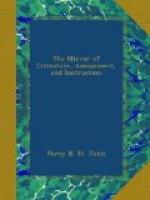Because the sugar is porous, and the air which filled its pores then escapes to the surface of the tea, and the liquid takes its place.
Why is there an opening in the centre of the upper stone of a corn mill?
Because through this opening the grain is admitted and kept turning round between the stones, and is always tending and travelling outwards, until it escapes as flour from the circumference.
Why does water remain in a vessel which is placed in a sling and made to describe a circle?
Because the water, by its inertia of straightness, or centrifugal (or centre-flying) force, tends more away from the centre of motion towards the bottom of the vessel, than towards the earth by gravity.
Why does a young quadruped walk much sooner than a child?
Because a body is tottering in proportion to its great altitude and narrow base. Now, the child has this latter, and learns to walk but slowly, because of the difficulty, perhaps in ten or twelve months, while the young of quadrupeds, having a broad supporting base, are able to stand, and even to move about almost immediately; but it is the noble prerogative of man to be able to support his towering figure with great firmness, on a very narrow base, and under constant change of attitude.—Arnott.
* * * * *
FINE ARTS.
THE ROYAL ACADEMY.
(From a Correspondent.)
The exhibition of works of art in the Royal Academy this year is equal to any preceding, except in the department of portraiture; nor is this deficiency by any means extraordinary, when we consider the severe loss the arts have sustained by the death of Sir Thomas Lawrence. We much regret that, out of one thousand two hundred and thirty-four productions, we can only enumerate a very small number for want of space:
No. 11. Dutch Coast—very fine and transparent in the colouring; painted by A. W. Callcott, R. A.
16. A Subject from the Winter’s Tale—good. W. H. Worthington.
55. Progress of Civilization—painted for the Mechanics’ Institute at Hull. This work is admirably conceived, and reflects great credit on the talents of Mr. H. P. Briggs.
56. Mary Queen of Scots meeting the Earl of Bothwell between Stirling and Edinburgh. Mr. Cooper has treated this subject with his usual care, and appears to have delineated the costume very accurately. The horses are spirited, and finely executed.
62. Portrait of Lady Lyndhurst—painted very much in the manner of Rembrandt, by D. Wilkie, R. A.
65 and 66. Portraits of their Majesties—painted for the Corporation of the Trinity House, by Sir William Beechy.
78. An Italian Family, by C. L. Eastlake, is an interesting picture, and extremely rich in colour.




